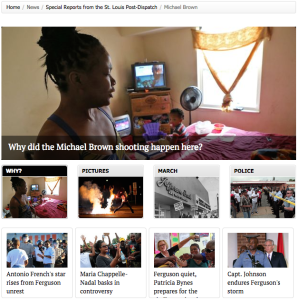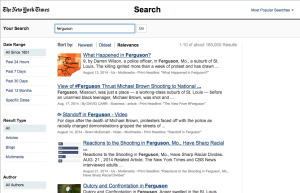Sarah Paterson, ENG-PWR ’15
Rhetoric is a pretty nifty media buzzword. Anytime someone – a politician, a news anchor, a football coach – says something polarizing, their statement can be written off as “just rhetoric.” This does a few things: it makes it hard for any student of rhetoric to explain their research to family at the holidays, and it limits public understanding of what rhetoric really is.
At its core, rhetoric is about communication of all kinds – verbal, written, visual. Contemporary understandings of rhetoric might suggest that rhetoric isn’t just about what inflammatory thing someone has said, but how and why they’ve said it. While the media might not be great at defining rhetoric, they do provide many examples of rhetorical situations.
In order to illustrate what rhetoric is and its place within popular media, we’re going to look at a recent controversial event – the police shooting of teenager Michael Brown and subsequent protests in Ferguson, Missouri – to see how media sources use rhetorical strategy to tell the same story in different ways.
Based on each source’s context, purpose, and audience, content, as well as style and delivery of that content, will differ. Today we will focus on online/print media, and Wednesday’s blog post will focus on television and social media.
New York Times (nytimes.com)
The New York Times is one of the most important papers of record in the US, and in recent years has built up a substantial online presence as well. It’s a trusted news source not just for Americans but also for people all over the world, and as such is a major way the reading public is educated on current events.
On the New York Times’s website, mentions of Ferguson have all but disappeared from the front page (there is one minor mention in a list of editorials that is easy to miss). Ferguson stories have been replaced with more international news (mainly ISIS), pop culture news, and information about the upcoming midterm elections. When one searches for Michael Brown or Ferguson, there is a collection of available articles but no organized page that shows all the articles together – no “home page.”
Because of its wide readership and its purpose of providing a broad range of information to the American people, the NYT has a few in-depth journalistic or editorial pieces about Ferguson, but it also contains a few “interactive” multimedia pieces that include videos, click-throughs, and photographs: a comprehensive timeline of all the major events, and a Q&A for an uninformed reader.
Links of note:
Timeline
Q&A
“Stacked With Warrants”
St. Louis Post-Dispatch (stltoday.com)
The St. Louis Post-Dispatch is St. Louis, Missouri’s print and online newspaper and the news source most local to Ferguson. Prior to the Ferguson shooting and riots, the Post-Dispatch did not have an audience that extended far past the state of Missouri.


The Michael Brown shooting still has its own “Hot Topic” tab on the front page of the website, at the top. The “Special Report” page is full of video links, photo galleries, and in-depth articles, many of which presume that local residents are more than familiar with the basics of the
Ferguson situation. Additionally, many of the articles are about the impact that the conflict will have on local politicians and community figures, like teachers and prominent protestors.
The Post-Dispatch page is photo-heavy and contains many interviews with residents of Ferguson and the surrounding area. The list of editorials contains hundreds of articles, listed in order of publication date. Not only is there more information about Ferguson on this page, but also the articles are less “think piece” style (like the NYT editorials) and more about immediate community impact of the violence.
Links of note:
Ferguson residents vent anger at city council meeting
Why did the Michael Brown shooting happen here?
For African-Americans in St. Louis, a long march for justice
Al Jazeera (america.aljazeera.com)
Al Jazeera is an international news outlet owned by the government of Qatar. While Al Jazeera initially began as an Arabic news network, it has since expanded into English-language versions with branches all over the world. Al Jazeera intentionally structures itself to lack an Anglo-American bias.
Like the New York Times, Al Jazeera America’s main page has bumped 
Ferguson coverage in favor of more major international conflicts. However, unlike the NYT, Al Jazeera has a home page where all of the Ferguson coverage is collected: “Flashpoint: Ferguson.”
Al Jazeera’s coverage of Ferguson is less locally focused and instead considers larger-scale implications of the Ferguson violence, mostly about race relations in the United States. It also includes articles that critique American coverage of the conflict, particularly by the New York Times. Unlike both other sources, Al Jazeera coverage is mostly text-based.
Additionally, all articles are displayed alongside conspicuous themed tags, which sort the articles into such categories as “civil rights,” “militarization,” “police,” “military,” and “race & ethnicity.” While articles in the NYTimes and the Post-Dispatch are also tagged, tags do not usually appear until the end of the article and only in a faint font.
Links of note:
New York Times’ Brown obit touched by lesser angels
‘His death is not in vain’: Mourners pay respects to Michael Brown
For police accountability, look beyond individual racial bias


 Follow
Follow
2 Comments
I like that you included the section on Al Jazeera at the end. As I was reading, I was trying to figure out why the New York Times would forget about the Ferguson shooting–something I find surprising since it is a liberally biased news source–and was coming to the conclusion that it was abandoning Ferguson in favor of more “important” stories happening. Until you mentioned Al-Jazeera, another international news source. Examining the biases and agendas of the NYT and Al Jazeera through the coverage and rhetoric of the Ferguson shootings would be a very interesting studying.
This article is really thought-provoking, and lead me to think about the various reasons “why” – rhetorically – the NYT might have muffled the Ferguson coverage in their newspapers (at least compared to other media outlets). First, if kinda makes you think about what kinds of invested interests they may have in focusing on international stories rather than the brutality happening here within our own police forces. I know that other media outlets, like Fox News, have resorted to using “assassination of character” to downplay the events leading up to Michael Brown’s death and elevate the image of the Ferguson police. You can draw many conclusions about these media biases and interests through rhetorical analysis, and this is certainly one of the most fascinating and frustrating news stories to analyze.
One Trackback
[…] This is part two of a two-part series on rhetoric in media. To read part one, click here. […]